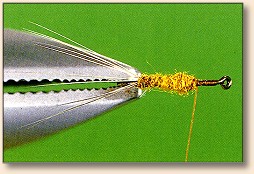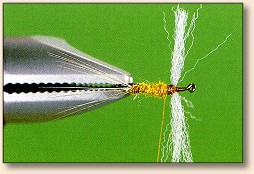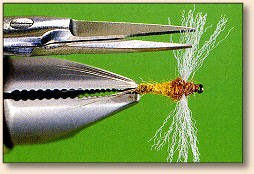Female Trico Polywing Spinner
By Dave Hughes
Though I commonly see the blue-winged olive color listed for spinner
dressing, it is my experience, and that of entomologists I know, that
almost all mayflies that start out as olives in the dun stage end up
as red quills or blue quills in the spinner stage. There are, however,
a few variations on the common red and blue colors themes that will
serve you well in your fly boxes. They are specific cases, and
should be addressed with flies tied especially to solve them.
The first of these is the tiny Trico (Tricorythodes). These are
prolific wherever flows are sluggish enough to allow the collection
of silt along the bottom. You'll find heavy hatches in almost all
meandering spring creek and meadow stream flows, most tailwaters,
and in the lower sections of major river systems, where the gradient
levels out somewhat and silt settles to the bottom. All of these
kinds of waters are defined by one common thread: trout, often big
ones, feeding on minute insects because they're so abundant.
Tricos hatch in July, August, and September in waters all across
the continent. They usually show up in the morning. Trout might
feed selectively on the size 22 and 24 nymphs, but it's rarely
been noticed, and its doubtful they become selective to them.
Trout also might focus on the duns, but again that is not very
common. But spinner falls of these insects are massed, a whole
flight of them moving over the water and dropping to the surface
almost at one time. Trout, even the largest of them, come up to
concentrate on them when that happens.
It's not always easy to notice Trico spinner falls. They can form
large, lifting and falling balls in the air, impossible to miss if
the light strikes them right. But they can also move over the water
and show up on the surface as if by magic. If you see trout that
appear to be rising to nothing, get your nose next to the water,
or better yet seine the currents with a net, and look closely to
see what shows up. If it's Trico spinners, you'll need to match
them to take trout.
You often need match no more than the size of such a small insect.
I have fished successfully through Trico spinner falls with dun
imitations, midge dressings, once even an ant pattern. But that
was out of neglect. I didn't have what I needed on me: Trico spinner
imitations. Don't let it happen to you. It doesn't take much tying
time to build a small supply, and they require very little room in
your fly boxes.
Male Tricos are typically dark brown in the abdomen and almost
black in the thorax. Females are often olive in the abdomen and
dark brown in the thorax. Both fall spent to the water, and trout
might key on one, the other, or both. I suggest you tie imitations
of both males and females, in one or two of the following styles.
Materials for the Female Trico Polywing Spinner
Hook: Standard dry fly, 1x fine, size 20 to 24.
Thread: Brown 8/0.
Tails: Blue dun hackle fibers, split.
Abdomen: Olive fur or synthetic dubbing.
Wings: White or pale gray Polypro yarn.
Thorax: Brown fur or synthetic dubbing.
Tying Instruction for the Female Trico Polywing Spinner:

Step 1: Fix hook in the vise and layer it with thread.
Form a small bump at the bend. Measure six to ten tail fibers
a bit longer than the hook length. Tie them in splayed, or
split in three sections. Twist fine olive synthetic dubbing
tightly to the hook, and wind a slender and tapered abdomen
over two-thirds of the shank.

Step 2: Separate out a small skein of Polypro yarn,
and cut it longer than you'll need it for the wings. Tie it
in across the top of the hook shank at the end of the body,
and use turns of thread and figure 8s to coax it into the
spent position.

Step 3: Twist fine brown synthetic dubbing to the thread.
Form a thorax by wrapping figure 8s of dubbing over the
wing tie-in point. Taper it forward to the hook eye. Form
a neat thread head, whip-finish, and clip the thread. Shape
the wings with your scissors, again without holding them so
they'll be the right length when you're finished. ~ DH
Credit: Female Trico Polywing Spinner is just one of the
great flies showing special techniques in Dave Hughe's book
Matching Mayflies published
by Frank Amato Publications.
|




